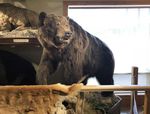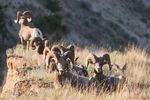Radium Hot Springs Visitor Centre Wildlife Exhibit
←
→
Page content transcription
If your browser does not render page correctly, please read the page content below
Radium Hot Springs Visitor Centre Wildlife Exhibit
For full details on animals in the exhibit, please visit us in person or email info@radiumhotsprings.com
Bighorn Sheep
(Ovis Canadensis)
Bighorn sheep are a famous attraction for Radium Hot Springs. During late October – early November they can
be seen around the village partaking in their famous head banging ritual and rutting activities.
The horns from a male Bighorn Sheep can grow to be up to 127 cm long (50 Inches). Adult Rams grow to be
about 100 cm (40 Inches) tall and weigh between 90-135 kg (200 – 300 lbs). A Ewe, a female Bighorn Sheep,
also grows horns but these are much smaller than the Ram’s horns. Bighorn sheep can live on average 12-14
years.
Mountain Goat
(Oreamnos americanus)
Mountain goats migrate to higher elevations for the winter months, whereas most animals migrate to the
valley bottom. They have adapted to a narrow, extreme niche where they can avoid competition from other
herbivores and predation by large carnivores.
Adult males (billies) weigh on average 70-120 kg (154-265 lbs), and adult females (nannies) 55-75 kg (120-165
lbs). Both have thin, black, stiletto-like horns up to 30 cm long which grow throughout their life and are never
shed. Male and female goats look similar, but their horns are slightly different; females horns are more
slender at the base and a bit more curved toward the tip than the males.Black Bears
(Ursus Americanus)
The black bear is the smallest and most widely distributed member of the bear family found in North America.
Black bears inhabit all areas of British Columbia except most urban cores. There are several different colours
of black bears that can occur in British Columbia, including cinnamon, brown, and blonde.
Black bears have a chunky body, small black eyes, a broad head, rounded ears, a short tail, and a fine, long
pelage. Adult males measure about 60 to 90 cm (24 to 35 inches) in shoulder height, 130 to 190 cm (51 to 75
inches) in length and weigh 80 to 300 kg (176 to 661 pounds). Females are smaller, weighing 40 to 140 kg (88
to 309 pounds). Cubs are born in January or February, during hibernation.
Grizzly Bear
(Ursus arctos horribilus)
The Grizzly Bear is the second largest carnivore in North America and is the largest bear in B.C. They can be
found from the west coast of B.C. to the eastern border of Manitoba.
Grizzly Bears have a strong, sturdy build with a large shoulder hump which distinguishes them from other
bears. Typically, their coats range in colour from blond to dark brown to cinnamon.
An adult male (boar) Grizzly Bear weighs between 250-350kg (550-770lbs.) and an adult female (sow) between
125-175kg (275-385lbs.). The average length of an adult is between 1.8-2.1 metres. Despite their large size
Grizzly Bears are very fast over short distances and can reach a top speed of approximately 55 km/hr. Average
life span of a Grizzly Bear is 20-25 years. A baby Grizzly is called a cub.Cougar
(Puma concolor)
The cougar, also called mountain lion, is Canada's largest cat. Cougars have long tails which may grow up to
one-third of their total body length.
An adult male (tom) cougar weighs between 63 and 90 kg (140-200 lbs), and a female cougar, between 40 and
50 kg (90-120 lbs). An adult cougar stands between 71 and 100 centimetres (28-40 inches) at shoulder height.
Their long tails are used to counter-balance their movements, making them appear graceful. The biggest
cougars are found in the interior and the Kootenay’s. On average, cougars live 8-14 years. Cougars breed
anytime of the year and could have 2-3 kittens at a time.
Wolverine
(Gulo Gulo)
The wolverine, particularly males which can be twice as big as females, is often mistaken for a small bear or a
large hoary marmot. Close in size to a medium dog, males can weigh up to 18 kg, while females are as heavy
as 12 kg. They have a rich, chocolate brown coat with blonde stripes down the sides. Individuals have unique
silvery markings on their face, which is broad and large for the body size.
In North America, wolverines range as far south as California, but south of the boreal forest, they are only
found in the most rugged mountain ranges, including Canada's Rocky Mountains.The Common Loon
(Gavia immer)
The common loon is a large, diving water bird. You will find this bird in the northern wilderness, the majority
of its time will be spent on the water, only coming ashore to nest. The loons are known for the black heads
and black banded necks, they have a long body with a short tail. Their diet consists of mostly fish, particularly
perch and sunfish. If fish are scarce or water is too murky for fishing, they will catch crustaceans, snails,
leeches and even insect larvae.
COMING IN 2018
American Badger
(Taxidea taxus)
Badgers can use hundreds of burrows within their home range as they search for food and mates.
The American Badger is a nocturnal member of the weasel family. Low-slung, with short, powerful legs and
impressive claws, this animal was "made to dig".
Its front claws are long and stout for ploughing through soil, while its hind claws are shorter and flattened for
shovelling it away. A badger can dig itself a hole in minutes!
The badger has brownish or greyish fur, with a white stripe running from its shoulder to the tip of its nose, and
dark markings on its face. Males, larger than females, weigh up to 14 kilograms.You can also read
























































